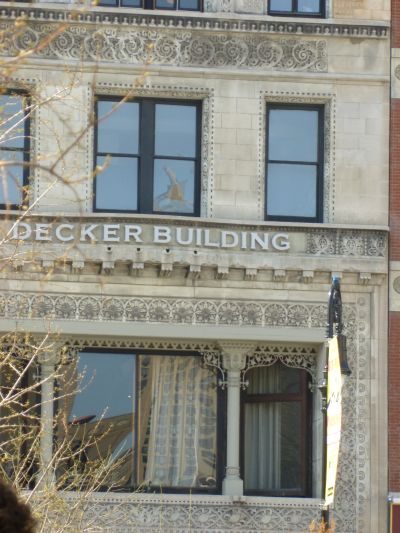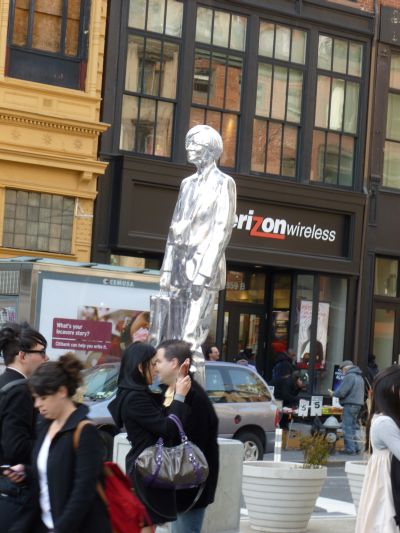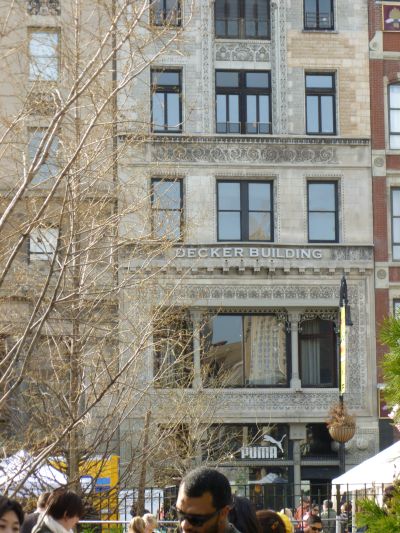 I was in the playground at Union Square with my boy where a long time ago Andy Warhol's old "Factory" was across the street and where recently a statue of him was erected nearby on Broadway. I was in the playground at Union Square with my boy where a long time ago Andy Warhol's old "Factory" was across the street and where recently a statue of him was erected nearby on Broadway.
I don't think it's coincidence that the rise of Andy Warhol and Pop Art came at a time when industrial arts and woodworking began its decline in schools. Warhol might represent a future of disposable, poorly made objects of the moment. Woodworking is the direct opposite. If something takes craft and materials to make, it's not something you want to get rid of. We all talk about making furniture that our kids and maybe grand-kids will have. I don't think any of us plan to build a room full of stuff only to have some decorator tell us next year that we have to get rid of it because it's not "now." You can only do that with disposable stuff. 
What's amusing of course about the whole thing is:
1: I'm not sure if the statue is permanent. It certainly doesn't look that way.
2: Unlike the Factory itself, which has been long gone for years, the Decker building in which it was housed is doing well, and the pre-Pop Art carvings that decorate the exterior still give bored parents in playgrounds something interesting to look at. Good design will outlast the hip and trendy every time.
 N.B. (The factory was only in the Decker building from 1968 - 1973, after which it moved a few feet away to the NE corner of Broadway and 17th Street, which is also visible from the playground. It's also an old building but it isn't as interesting as the Decker building.) N.B. (The factory was only in the Decker building from 1968 - 1973, after which it moved a few feet away to the NE corner of Broadway and 17th Street, which is also visible from the playground. It's also an old building but it isn't as interesting as the Decker building.)
N.B. Thanks to the farmers market at Union Square which started in 1976 and grown, Union Square has gone from being a cheap dodgy neighborhood with discount stores to a upscale area jammed with lots of tourists and locals. However, in the 19th century Union Square was a major focus of the city, and the headquarters of Tiffany & Co. before they moved uptown. The original store, which had one of the most prominent interior spaces of its time, has recently been converted to a glass covered condominium.
|
 Joel's Blog
Joel's Blog Built-It Blog
Built-It Blog Video Roundup
Video Roundup Classes & Events
Classes & Events Work Magazine
Work Magazine


 I was in the playground at Union Square with my boy where a long time ago Andy Warhol's old "Factory" was across the street and where recently a statue of him was erected nearby on Broadway.
I was in the playground at Union Square with my boy where a long time ago Andy Warhol's old "Factory" was across the street and where recently a statue of him was erected nearby on Broadway. 
 N.B. (The factory was only in the Decker building from 1968 - 1973, after which it moved a few feet away to the NE corner of Broadway and 17th Street, which is also visible from the playground. It's also an old building but it isn't as interesting as the Decker building.)
N.B. (The factory was only in the Decker building from 1968 - 1973, after which it moved a few feet away to the NE corner of Broadway and 17th Street, which is also visible from the playground. It's also an old building but it isn't as interesting as the Decker building.)
Check this article http://books.google.com/books?id=gOMCAAAAMBAJ&pg=PA26&lpg=PA26&dq=andy+warhol+estate+sale+sothebys&source=bl&ots=jn1ZoKFkyX&sig=LQax2ab6_RT1sMX6Wdzn-LJuyoA&hl=en&ei=u5jCTZTRAouXtweazvWzBQ&sa=X&oi=book_result&ct=result&resnum=5&ved=0CDIQ6AEwBA#v=onepage&q&f=false
I'm judging the guy by what he produced and his influence. He was a complex guy, most creative people are.
What I found amusing is that here is a building that housed the single most important pop artist and one of the most important artists of the mid-late 20th century. But there is no evidence of it. The owners of the building kept the original detail of the building. Why? In my view no matter what the message of Pop Art is, it was meant for the here and now, which has passed, and average people like myself would much rather look at something well made, than dated hip and trendy.
Maybe the medium IS the message? And what people respond to for real, once the shock of the new is worn out, is craft and the things that are well made and designed. There might be some hidden meaning in the designs of the Decker building, and maybe in Pop Art too, but that's not what I respond to and I think most people don't either.
N.B. - Contractors and Subs have been complaining about architects since the beginning of the profession - don't let it get you down.